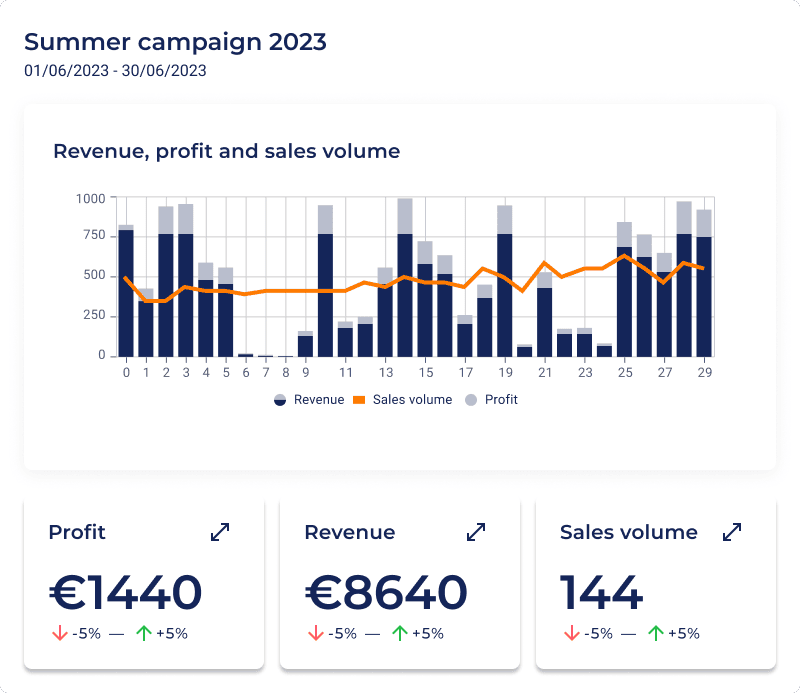Competition in ecommerce pricing plays a crucial role in shaping pricing strategies for businesses operating in the ever-changing world of ecommerce. In the vast digital marketplace, numerous companies are vying for the attention and wallets of online shoppers. To succeed in this competitive landscape, it’s essential for businesses to understand competition dynamics and use effective pricing strategies. In this blog post, we will explore the significance of competition in ecommerce pricing and discuss various strategies that can help companies gain a competitive edge.
Maximize your campaign profits
Sniffie: Smart Sale & Discount Campaign App is the ultimate power tool for Shopify stores to create easy and optimized campaigns. With the use of cutting-edge AI, you can maximise your profits all while reducing prices.

Unveiling the landscape of competition in ecommerce pricing
The ecommerce arena is an ever-changing battleground where companies, both established giants and nimble startups, wage a fierce war for market dominance and customer loyalty. Staying relevant and achieving success in this cutthroat environment requires a keen understanding of the competitive landscape. Here are some key aspects that demand your attention:
- Market Trends and Industry Shifts: The ecommerce industry is a dynamic beast, constantly evolving with trends and frequent shifts. It’s crucial to monitor market trends and keep a close eye on industry changes that can significantly impact your pricing decisions. Whether it’s the advent of mobile commerce, shifting consumer preferences, or disruptive technologies, understanding these influences will empower you to craft effective pricing strategies.
- Competitor Analysis: Thoroughly analyzing your competitors is like peering into their secret playbook. By gaining insights into their pricing tactics, value propositions, and customer experiences, you can gain a competitive edge. Studying your rivals’ pricing models and promotions will help you identify effective strategies and uncover areas where you can differentiate yourself from the pack.
- Customer Insights: Your customers hold the key to unlocking pricing success. To make informed pricing decisions, it’s essential to understand their needs, preferences, and expectations. By harnessing customer insights and conducting market research, you can uncover valuable information such as price sensitivity, demand elasticity, and willingness to pay. Armed with these insights, you can tailor your pricing strategies to effectively target specific customer segments.
The Power of Competition: Shaping Pricing Strategies
Competition in ecommerce pricing is akin to a thrilling battle, and to emerge victorious, you need a well-crafted strategy. In this section, we’ll delve into how competition in ecommerce pricing influences pricing strategies. On top of that we will unveil successful tactics to overcome your rivals. Let’s explore the ways competition in ecommerce pricing impacts your pricing endeavors:
- Competitive Pressure: When competitors lurk in the marketplace, the pressure to offer competitive prices intensifies. This often leads to intense price wars, where companies engage in a fierce downward spiral of lowering prices to attract customers. To remain competitive, you must be agile, constantly adjusting your pricing strategy to strike the right balance. Additionally, the digital nature of ecommerce has ushered in pricing transparency, enabling consumers to effortlessly compare prices across platforms. This transparency places businesses under scrutiny, compelling them to offer competitive prices and avoid losing customers to rivals. To succeed, your pricing decisions must be grounded in market realities and aligned with customer expectations.
- Product Differentiation: In a crowded marketplace, standing out is paramount. Offering unique products or services sets you apart from the competition. However, it’s crucial to reflect the value of your offerings in your pricing strategy, as this directly impacts the price customers are willing to pay. Remember, your competitors are also leveraging their unique value propositions. Thus, practicing competitive benchmarking becomes vital. By understanding how your rivals differentiate their products, you can strategically position your offerings. Analyzing their strengths and weaknesses empowers you to adjust your pricing strategies to emphasize your distinctive value propositions. This not only establishes a unique market position but also enhances perceived value.
- Target Market Segmentation: Your competitors may be targeting different customer segments, necessitating adjustments to your pricing strategy. Luxury brands, for instance, charge premium prices to cater to customers seeking exclusivity, while budget brands focus on attracting price-sensitive shoppers with lower prices. Understanding the level of price sensitivity within your customer segment is crucial for crafting pricing strategies that combat competition effectively. In crowded markets, customer perceptions of pricing are significantly influenced by the competitive landscape.
Like what you’re reading?
Take our free “Understanding Your Competition” course in our Pricing Academy!

Successful Pricing Strategies: Winning the Battle
Now that we grasp how competition shapes pricing strategies, let’s unlock the secrets of success. Below, we present some proven pricing strategies that will empower you to compete and overcome the competition in ecommerce pricing.
1. Price Matching: Harness the power of price matching to stay competitive. This strategy involves matching the prices of your rivals to ensure customers receive the best deal from you. Price matching is a powerful tool for attracting price-sensitive customers who actively compare prices across platforms. By offering competitive prices, you can maintain your market share and prevent customers from choosing competitors solely based on price. However, exercise caution, carefully assessing the impact of price matching on profitability. Implement this strategy selectively to avoid engaging in unsustainable price wars.
2. Dynamic Pricing: Unleash the potential of dynamic pricing, a strategy that adjusts prices in real-time based on supply and demand dynamics, market conditions, and competitor activities. By leveraging data analytics and intelligent pricing algorithms, you can optimize prices for maximum profitability while remaining competitive. Dynamic pricing empowers you to adapt swiftly to market changes and rival pricing, allowing you to seize opportunities and avoid leaving money on the table. For instance, during periods of high demand or intense competition, adjusting prices upwards maximizes revenue. Conversely, during low demand or when facing competitive price cuts, lowering prices attracts customers and maintains your market share. Implementing dynamic pricing successfully requires a deep understanding of market dynamics, accurate data analysis, and leveraging intelligent pricing tools.
3. Value-Based Pricing: Unlock the power of value-based pricing, a strategy rooted in the perceived value of your products or services to customers. Instead of solely considering production costs and desired profit margins, businesses charge prices that reflect the unique value they provide. This strategy is often employed by luxury brands and businesses that emphasize superior quality, innovation, convenience, or exceptional customer service. By effectively communicating and demonstrating the value customers will receive, you can justify higher prices and attract customers willing to pay a premium. To execute value-based pricing successfully, comprehensively understand your customers’ needs, preferences, and perceptions of value. Invest in building strong brand equity, emphasizing your unique value propositions, and differentiating yourself from competitors to command premium prices successfully.
4. Bundling: Embrace the power of bundling to craft enticing offerings. This strategy involves offering multiple products or services as a package at a discounted price. Bundling increases the perceived value of your offering, attracts price-sensitive customers, and encourages upselling. By bundling complementary products or services, you can leverage cross-selling opportunities, increase the average order value, and create a competitive advantage. Bundling also allows you to differentiate yourself from competitors by offering unique combinations of products or services. Effective bundling requires careful analysis of customer preferences, identification of synergistic offerings, and setting pricing that provides customers with a compelling reason to choose the bundled package over individual purchases.
Conclusion: Conquer the Ecommerce Battlefield
In conclusion, competition in ecommerce pricing exerts a profound influence on pricing strategies. As an ecommerce or pricing manager, understanding the competitive landscape, monitoring market trends, analyzing competitors’ pricing tactics, and leveraging customer insights are key ingredients for developing effective pricing strategies. By implementing successful pricing strategies such as price matching, dynamic pricing, value-based pricing, and bundling, your business can enhance competitiveness, attract and retain customers, and drive long-term success in the highly competitive ecommerce market. Now, armed with these insights, it’s time for you to conquer the ecommerce battlefield and emerge as the victor in this exhilarating world of online retail!



